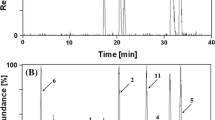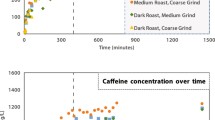Abstract
There is no consensus in the literature regarding the decrease of kahweol and cafestol contents during coffee roasting, but it has been reported that these compounds can undergo dehydration under heat. Kahweol and cafestol were quantified in Arabica and Robusta coffees with different roasting degrees (2, 4, 6, 8 and 10 min at 230 °C). The structures of the diterpenes and the presence of derivative compounds were determined by liquid chromatography with UV–Vis and mass spectrometry detection. In the dark roast samples, dehydro derivatives were found. The roasting process influenced the level of diterpenes in both species of coffee, but the effect was dependent on the intensity of the process. Cafestol and kahweol were degraded (general losses from 60 to 75 % on a lipid basis) to dehydrocafestol and dehydrokahweol, respectively, after 8 min of process, which corresponds to the commercial roasting degree. On the other hand, the amounts of cafestol and kahweol (mg/100 g of coffee) remained stable during the roasting process due to relative increase in lipid concentration.






Similar content being viewed by others
References
Cano-Marquina A, Tarín JJ, Cano A (2013) The impact of coffee on health. Maturitas 75:7–21
Arruda NP, Rezende CC, Couri S, Pereira SF, Silva CG (2009) Perfil de voláteis, compostos fenólicos, atividade antioxidante e fator de proteção solar em óleo de café extraído por etanol. In: 32 Reunião Anual da Sociedade Brasileira de Química
Boekschoten MV, Engberink MF, Katan MB, Schouten EG (2003) Reproducibility of the serum lipid response to coffee oil in healthy volunteers. Nutr J 2:1–8
Cavin C, Holzhäuser D, Scharf G, Constable A, Huber WW, Schilter B (2002) Cafestol and kahweol, two coffee specific diterpenes with anticarcinogenic activity. Food Chem Toxicol 40:1155–1163
Naidoo N, Chen C, Rebello SA, Speer K, Tai ES, Lee J, Buchmann S, Koelling-Speer I, Rm VD (2011) Cholesterol-raising diterpenes in types of coffee commonly consumed in Singapore, Indonesia and India and associations with blood lipids: cholesterol-raising diterpenes in types of coffee commonly consumed in Singapore. Nutr J. doi: 10.1186/1475-2891-10-48
Liu Y, Kitts DD (2011) Confirmation that the Maillard reaction is the principle contributor to the antioxidant capacity of coffee brews. Food Res Int 44:2418–2424
Kurzrock T, Speer K (2001) Diterpenes and diterpene esters in coffee. Food Rev Int 17:433–450
Oliveira LS, Franca AS, Mendonça JCF, Barros-Júnior MC (2006) Proximate composition and fatty acids profile of green and roasted defective coffee beans. LWT Food Sci Technol 39:235–239
Toci AT, Neto VJMF, Torres AG, Farah A (2013) Changes in triacylglycerols and free fatty acids composition during storage of roasted coffee. LWT Food Sci Technol 50:581–590
Gloess AN, Schönbächler B, Klopprogge B, D’Ambrosio L, Chatelain K, Bongartz A, Strittmatter A, Rast M, Yeretzian C (2013) Comparison of nine common coffee extraction methods: instrumental and sensory analysis. Eur Food Res Technol. doi:10.1007/s00217-013-1917-x
Urgert R, Van Der Weg G, Kosmeijer-Schuil TG, Van De Bovenkamp P, Hovenier R, Katan MB (1995) Levels of the cholesterol-elevating diterpenes cafestol and kahweol in various coffee brews. J Agric Food Chem 43:2167–2172
Campanha FG, Dias RCE, Benassi MT (2010) Discrimination of coffee species using kahweol and cafestol effects of roasting and of defects. Coffee Sci 05:87–96
De Souza RMN, Benassi MT (2012) Discrimination of commercial roasted and ground coffees according to chemical composition. J Braz Chem Soc 23:1347–1354
Wermelinger T, D’Ambrosio L, Klopprogge B, Yeretzian C (2011) Quantification of the Robusta fraction in a coffee blend via Raman spectroscopy: proof of principle. J Agric Food Chem. doi:10.1021/jf201918a
Grollier JF, Plessis S (1998) Use of coffee bean oil as a sun filter. US Patent US4793990
Bertholet R (1988) Preparation of a mixture of cafestol and kahweol. US Patent US4748258 A
Baggenstoss J, Poisson L, Luethi R, Perren R, Escher F (2007) Influence of water quench cooling on degassing and aroma stability of roasted coffee. J Agric Food Chem 55:6685–6691
Franca AS, Oliveira LS, Oliveira RCS, Agresti PCM, Augusti R (2009) A preliminary evaluation of the effect of processing temperature on coffee roasting degree assessment. J Food Eng 92:345–352
Bottazzi D, Farina S, Milani M, Montorsi L (2012) A numerical approach for the analysis of the coffee roasting process. J Food Eng 112:243–252
Oosterveld A, Voragen AGJ, Schols HA (2003) Effect of roasting on the carbohydrate composition of Coffea arabica beans. Carbohydr Polym 54:183–192
Redgwell RJ, Trovato V, Curti D, Fischer M (2002) Effect of roasting on degradation and structural features of polysaccharides in arabica coffee beans. Carbohydr Res 337:421–431
Speer K, Kölling-Speer I (2006) The lipid fraction of the coffee bean. Braz J Plant Physiol 18:201–216
Lago RCA (2001) Lipídios em grãos. Boletim do CEPA 19:319–340
Hruschka A, Speer K (1997) Cafestal in coffee. In: Amadò R, Battaglia R (eds) Proceedings of Euro Food Chem IX, Interlaken, Switzerland, vol 3, pp 655–658
Speer K, Hruschka A, Kurzrock T, Kölling-Speer I (2000) Diterpenes in coffee. In: Parliament TH, Ho C-T, Schieberle P (eds) Caffeinated beverages, health benefits, physiological effects, and chemistry. ACS symposium series 754, pp 241–251
Dias RCE, Faria AF, Mercadante AZ, Bragagnolo N, Benassi MT (2013) Comparison of extraction methods for kahweol and cafestol in roasted coffee. J Braz Chem Soc 24:492–499
Dias RCE, Campanha FG, Vieira LGE, Pereira LP, Pot D, Marraccini P, Benassi MT (2010) Evaluation of kahweol and cafestol in coffee tissues and roasted coffee by a new high-performance liquid chromatography methodology. J Agric Food Chem 58:88–93
Rubayiza AB, Meurens M (2005) Chemical discrimination of arabica and robusta coffees by Fourier transform Raman spectroscopy. J Agric Food Chem 53:4654–4659
Kurzrock T, Speer K (2001) Identification of kahweol fatty acid esters in arabica coffee by means of LC/MS. J Sep Sci 24:843–848
Roos B, Van Der Weg G, Urgert R, Van De Bovenkamp P, Charrier A, Katan MB (1997) Levels of cafestol, kahweol, and related diterpenoids in wild species of the coffee plant Coffea. J Agric Food Chem 45:3065–3069
Speer K, Mischnick P (1989) 16-O-Methylcafestol-ein neues Diterpen im Kaffee Entdeckung und Identifizierung. Eur Food Res Technol. doi:10.1007/BF01028067
Pettitt Junior BC (1987) Identification of the diterpene esters in arabica and canephora coffees. J Agric Food Chem 35:549–551
Guerrero G, Suárez M, Moreno G (2005) Chemosystematic study of diterpenoids in green coffee beans. In: International conference on coffee science (ASIC), pp 292–296
Kölling-Speer I, Kurt A, Nguyen T, Speer K (1997) Cafestol and dehydrocafestol in roasted coffee. In: International colloquium on the chemistry of coffee, pp 201–204
Acknowledgments
The authors thank the Brazilian Funding Agencies FAPESP, CNPq and CAPES for the financial support supplied, and Companhia Iguaçu de Café Solúvel® (Cornélio Procópio, Brazil) for providing the coffee samples.
Conflict of interest
The authors declare that they have no conflict of interest.
Author information
Authors and Affiliations
Corresponding author
Appendix
Rights and permissions
About this article
Cite this article
Dias, R.C.E., de Faria-Machado, A.F., Mercadante, A.Z. et al. Roasting process affects the profile of diterpenes in coffee. Eur Food Res Technol 239, 961–970 (2014). https://doi.org/10.1007/s00217-014-2293-x
Received:
Revised:
Accepted:
Published:
Issue Date:
DOI: https://doi.org/10.1007/s00217-014-2293-x






